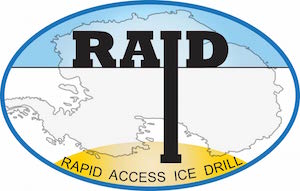1st RAID Science Planning Workshop, 2017
Science Planning Workshop for Research with the Rapid Access Ice Drill
March 2-3, 2017
Scripps Institution of Oceanography
La Jolla, California
A science planning workshop focused on future deployment of the Rapid Access Ice Drill (RAID) was held in La Jolla, California on March 2-3, 2017. The workshop was convened by Jeff Severinghaus and John Goodge, and it was supported by an award from the Office of Polar Programs at the National Science Foundation. Participants included researchers representing the fields of glaciology, paleoclimate, ice dynamics, glacial interface, subglacial landscape, bedrock geology, geophysics, and geodetics. Goals and other information related to the meeting are included below. A final workshop agenda and a workshop report are available for download below:
• RAID Science Planning Workshop Agenda
• RAID Science Planning Workshop Report
Conveners:
Jeff Severinghaus, Scripps Institution of Oceanography
John Goodge, University of Minnesota Duluth
We invited interested researchers to participate in a science planning workshop to help shape future interdisciplinary research with the Rapid Access Ice Drill (RAID). Goals and initial planning for the workshop are outlined below.
Goals of the workshop: RAID is in Antarctica! Now is a good time to bring together the scientific community interested in using the RAID system for deep glacial and subglacial sampling, and for the boreholes it will create, including integrated ice drilling, ice and rock coring, borehole logging, and geophysical data acquisition. This workshop provided a venue to bring scientists together to explore new science questions or approaches; define science goals; seek synergies between different disciplines for RAID; and develop a coherent community science plan for use of this unique drilling system. The workshop was a great opportunity to bring together researchers with scientific interests in ice-sheet dynamics, paleoclimate, borehole logging, the ice-sheet interface, exposure and uplift histories, subglacial bedrock geology, subglacial sediments, microbiology, heat flow, potential-field geophysics, seismology, geodetics, and ice-penetrating radar.
When: Thursday and Friday, March 2-3, 2017, convened from 0800-1800 each day.
Where: Scripps Institution of Oceanography and University of California San Diego in La Jolla. The meeting venue was at Martin Johnson House on the SIO campus. Accommodations were provided at hotels near the SIO campus.
Who: The workshop was open to all scientists interested in using or contributing to the science enabled by RAID. We encouraged young investigators and under-represented groups to participate.
Cost: There was no meeting registration cost. Breakfast and lunch meals were provided. An NSF award to SIO provided partial travel to US participants for travel and accommodation. Preference was given to young and under-represented investigators.
Responses: Interested participants provided an expression of scientific interest by filling out a short form in order to plan for the number of attendees and workshop agenda.
Contact information:
Jeff Severinghaus – jseveringhaus@ucsd.edu
Tomomi Ushii – tomomi@ucsd.edu
John Goodge – jgoodge@d.umn.edu
The RAID science workshop was a great success! We thank all of those who participated.
What is RAID?
The Rapid Access Ice Drill is a mobile system capable of rapidly drilling deep boreholes in the Antarctic ice sheets and retrieving cores of deep ice, the glacial bed, and bedrock below. It will provide a critical first look at the interface between major ice caps and subglacial features over a wide area. RAID is designed to enable interdisciplinary research, including direct observation at the base of the modern ice sheets, access to polar paleoclimate records in ice >1 Ma, and recovery of billion-year rock cores from ice-covered East Antarctica, among many other multidisciplinary topics of interest that RAID can address. Because of its traversing capability, RAID can quickly make deep boreholes that will remain open for future down-hole observation. The RAID system was designed and optimized for drilling and coring in dry, frozen-bed conditions as will be encountered in the thick East Antarctic ice sheet. The initial operating region for RAID will be in the vicinity of and radiating from South Pole station toward the ice sheet interior.
What can RAID do? With an ice-cutting rate of up to 3 m/min, RAID is capable of making rapid boreholes in thick ice followed by coring in ice, the glacial bed, and subglacial bedrock.
Example drilling targets include:
• ice borehole — laser/optical logging to determine age of ice; acoustic log of deformation
• short ice cores — reconnaissance sampling of ‘old’ ice (>1 Ma?)
• glacial bed — ice flow conditions, basal material, microorganisms
• short rock cores — samples for age dating, composition, surface exposure ages, crustal and uplift history, validation of potential-field characteristics
• rock borehole instrumentation — heat flow, seismology, geodetics
RAID status: RAID is currently on the ice.
Recent developments include:
• design completed in late 2013
• construction and outfitting of modules began in Utah in mid-2014
• construction of cryogenic ice-drilling facility in Utah in early 2015
• North American test of key components and drilling rates completed in March 2015
• fabrication and construction of all major sub-systems in Utah in 2015
• completion of integration and validation in October 2015
• commissioned in early November 2015
• shipment to Antarctica complete in January 2016
• winter-over storage in McMurdo
• Antarctic Field Trials in progress during December 2016 near McMurdo Station
